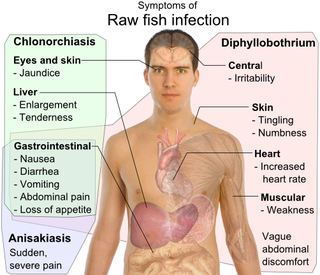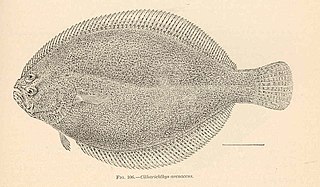
Clonorchiasis is an infectious disease caused by the Chinese liver fluke, Clonorchis sinensis, and two related species. Clonorchiasis is a known risk factor for the development of cholangiocarcinoma, a neoplasm of the biliary system.

Sinosaurus was a tetanuran theropod dinosaur which lived during the Early Jurassic Period. It was a bipedal carnivore approximately 5.6 metres in length. Fossils of the animal were found at the Lufeng Formation, in the Yunnan Province of China.
Gastropsetta frontalis, the shrimp flounder, is a species of large-tooth flounder, the only member of its genus Gastropsetta. It is endemic to the western Atlantic Ocean, from North Carolina to Florida, and from the northern Gulf of Mexico to Panama. It also occurs in The Bahamas.

Paralichthys adspersus, the fine flounder, is a species of large-tooth flounder native to the eastern Pacific Ocean, along the continental shelf from the coast of Ecuador in the north to the coast of Peru in the south.

The olive flounder, bastard halibut or Japanese halibut is a temperate marine species of large-tooth flounder native to the north-western Pacific Ocean.

The summer flounder is a marine flatfish that is found in the Atlantic Ocean off the East Coast of the United States and Canada. It is especially abundant in waters from North Carolina to Massachusetts.

Hippoglossina oblonga, is a flatfish and member of the large-tooth flounder family Paralichthyidae. This species has been placed in the genus Paralichthys by some authorities.
Thysanopsetta naresi is a species of flatfish in the large-tooth flounder family, Paralichthyidae. It is the only member of its genus Thysanopsetta . Thysanopsetta naresi is a demersal fish that lives in temperate waters at depths of between 90 and 170 metres. It can be found in the southeast Pacific Ocean, off the coast of Chile, and in the southwest Atlantic Ocean in the Patagonian Falkland region. It grows to around 15.1 centimetres (5.9 in) in length.
Pseudorhombus quinquocellatus, the five-eyed flounder, is a species of flatfish in the large-tooth flounder family, Paralichthyidae. It is a demersal fish that lives in tropical waters, inhabiting deep waters on the continental shelf of the western Pacific Ocean, from Taiwan in the north to Australia in the south.
Citharichthys gordae, the mimic sanddab, is a species of sanddab in the large-tooth flounder family Paralichthyidae. It is native to the eastern Pacific Ocean, found off the coast of Mexico. It has a limited distribution, found in the Magdalena Bay and along the Baja California peninsula, as well as part of the Gulf of California.
Citharichthys platophrys, the small sanddab, is a species of sanddab in the large-tooth flounder family Paralichthyidae. It is native to the eastern Pacific Ocean, ranging from the southern Gulf of California of Mexico in the north to Peru in the south.
Citharichthys fragilis, the Gulf sanddab, is a species of sanddab in the large-tooth flounder family Paralichthyidae. It is native to the eastern Pacific Ocean, ranging from the coast of Manhattan Beach, California in the north to the Gulf of California in the south.

Etropus rimosus, the gray flounder, is a species of flounder in the large-tooth flounder family Paralichthyidae. It is native to the western Atlantic Ocean, ranging from the coast of North Carolina to the south of Florida. It can also be found in the eastern Gulf of Mexico.
T. sinensis may refer to:
Citharichthys gymnorhinus, the anglefin whiff, is a species of flatfish in the large-tooth flounder family Paralichthyidae. It is a demersal marine fish that inhabits the mid to outer continental shelf of the western Atlantic Ocean, in both tropical and subtropical waters. It ranges from the Bahamas and Florida in the north to Guyana and Nicaragua in the south, though larvae samples have also been collected off the coast of Canada. It occurs at depths between 35 and 200 metres, but is most commonly found in shallower waters.
Citharichthys gilberti, the bigmouth sanddab, is a species of flatfish in the large-tooth flounder family Paralichthyidae. It is native to the eastern Pacific Ocean, in tropical waters ranging from the Gulf of California in the north to Peru in the south. It occurs in shallow waters off the coast, to a maximum depth of 36 m (118 ft).
Citharichthys mariajorisae, the five-rayed sanddab, is a species of flatfish in the large-tooth flounder family Paralichthyidae. It is native to the eastern Pacific Ocean, in tropical waters ranging from the Gulf of California in the north to the Bay of Panama in the south. It is a demersal marine fish, inhabiting the sandy bottoms of shallow coastal waters at a depth between 10 and 45 metres.
Citharichthys xanthostigma, the longfin sanddab, is a species of flatfish in the large-tooth flounder family Paralichthyidae. It is native to the eastern Pacific Ocean, in subtropical waters ranging from Monterey Bay, California in the north, to Costa Rica in the south. It is a demersal marine fish, and can be found on the soft bottoms of coastal waters at depths between 2 and 201 metres.
Citharichthys abbotti, the Veracruz whiff, is a species of flatfish in the large-tooth flounder family Paralichthyidae. It is endemic to the southwestern Gulf of Mexico, found on the Eastern Mexico Continental Shelf, with Veracruz to the south and the Rio Grande to the north.

Citharichthys arenaceus, the sand whiff, is a species of flatfish in the large-tooth flounder family Paralichthyidae. This demersal marine fish inhabits the western Atlantic Ocean, occurring in shallow tropical coastal waters, as well as in estuaries, bays, and lagoons. It ranges from Florida, United States, in the north to the West Indies and Brazil in the south.












